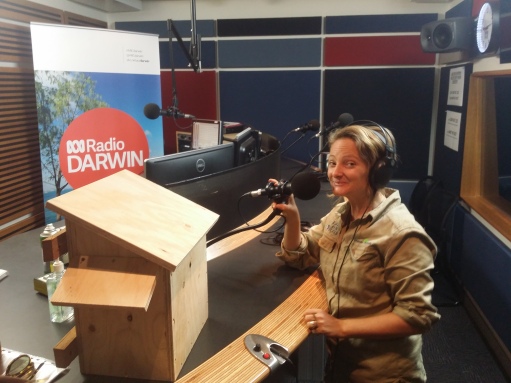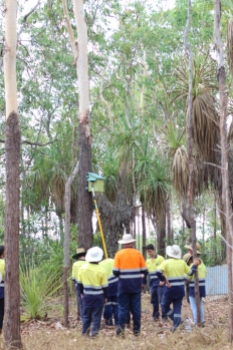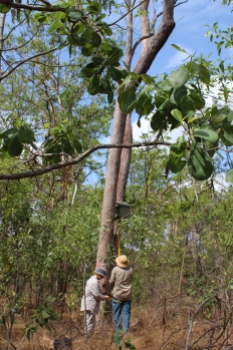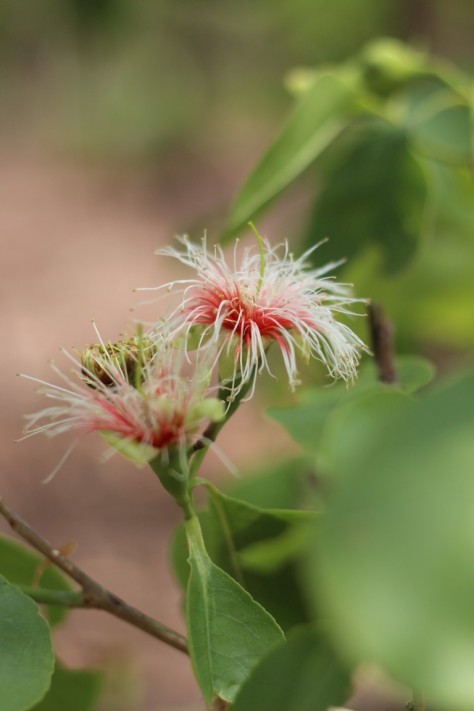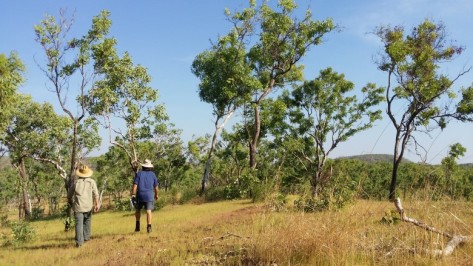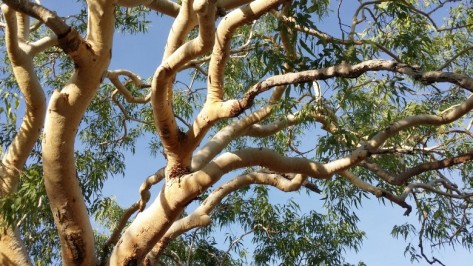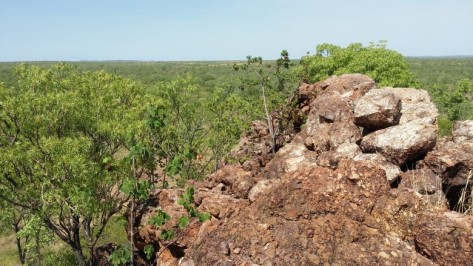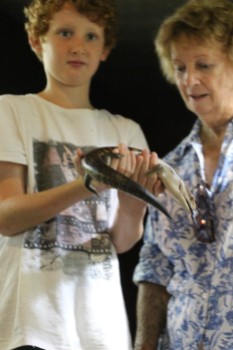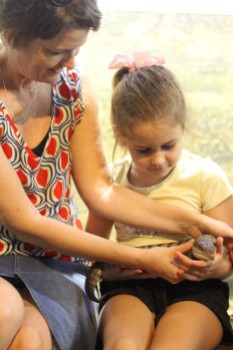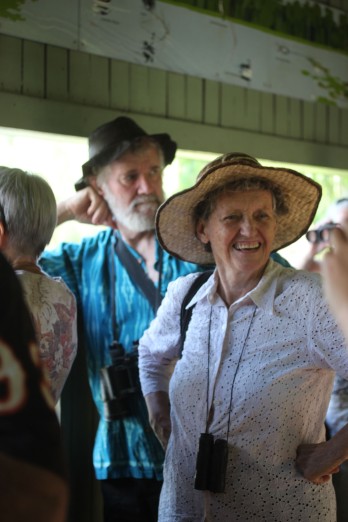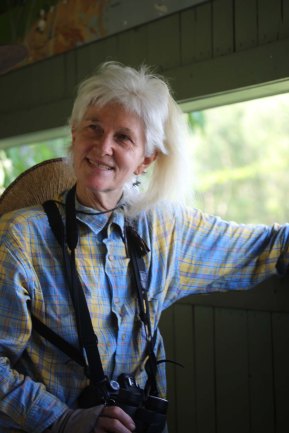
It really is fantastic that landholders are pledging to conserve and manage land as wildlife habitat, particularly as more land is subdivided and more people inhabit our rural areas and beyond. A lot of land is in the care of private landholders. Managing land and keeping it as beautiful intact vegetation to support a diversity of species is so rewarding, but not always easy. Management issues arise and the most commonly mentioned one on visits to new and existing member properties is that of weeds, shortly followed by fire, and often involving relations with nearby landholders.
Weed management is quite high up on everyone’s list, but can cause stress and aggravation. If you are busy, it may feel like a never ending task that you can’t get time to finish. It can be frustrating, particularly as negative energy is being targeted at plants, and if you love plants (I certainly do), that can be weird. However weeds are plants out of place, this can mean different things dependent on the land manager’s perspective. If you are a pastoralist some “weed plants” may be seen as beneficial as they are food for cattle, so are not seen as weeds. Many other “weed plants” may be seen as food, medicine, or ornamentals that are beneficial to humans. If you are looking after land to keep its ecological integrity and support all wildlife species (plants and animals) and their interactions, then non-native plants that compete with natives and change the fire regime to degrade diversity are not welcome and are out of place.
The major weeds are grassy weeds that change the fire regime- with the highest priority to Gamba Grass. Mission grass comes in as another weed to tackle that can change fire regime and is very competitive and Rat’s Tail grass is now creeping up the list, but has not yet been declared. There are many other weeds which are highly vegetatively competitive and often are medium sized herbs. The most common seen on LFW properties are Snake Weed, Hyptis, Sida, Crotolaria, Neem and some other aquatic weeds when landholders have lagoons. We have some more info on our weeds page, and links to the Weeds Branch website, which is very useful.
The idea of our Weed Workshop was to increase members’ weed awareness and ability to ID weeds, help participants access resources and assistance to aid weed management and allow members to share stories and strategies on weed management to assist one another.

The main workshop was kindly hosted on Rod and Bhavini’s 9 acres (4 hectare) property in Humpty Doo. This property merges from Open Woodland into a Lagoon. The middle of the lagoon is 38 acre (17 hectare) zoned for conservation and managed by Litchfield Council. The landholders also own one neighbouring property and another LFW property is located across the north side of the lagoon. The majority of the host’s block goes underwater in a good wet season and its location backing on to the lagoon with minimal fencing gives it some great values in habitat connectivity, but also adds to the diversity of potential weed species.

Over 30 Land for Wildlife members came along on this steamy Saturday morning to be involved. Some had some long term tried and tested weed strategies and others were new to the weeds found here, so a perfect balance to exchange information at a grass roots/ landholder level, as well as have a weed expert on hand.
We kicked of the session, after a quick intro, with members getting into small groups with people they had not met before to share where the property they managed was, what they loved about it, what weeds they had on it and how they felt about this right now. This is a bit like speed (weed) dating, but without the swapping over.
After this the host landholders took us on a tour of the property and familiarised us with some of the common weeds found on many rural properties and their management efforts, as well as pointing out some of the beautiful features.

Rod purchased the property over 10 years ago and lived on it for several years, but then after marrying Bhavini moved to town and rented it out to friends, continuing to visit and stay on it to manage weeds (and monitor regrowth) The property had previously been mostly cleared around the house area, with some larger trees remaining and a huge infestation of Mission grass and some Gamba patches. Slowly after a lot of hand pulling and slashing, the wall of Mission grass on the margins of the lagoon started to disappear. An array of other smaller weeds continue to pop up in previously disturbed areas. Rod and Bhavini continue to come and stay at the property when no tenants are there to manage the weeds and enjoy the landscape. Rod works with Bush Tucker and Land Management projects in Arnhem Land.
Some top tips (from Rod and Bhavini)–
- Focus on manageable patches of weeds, put parameters or lines on an area and do not let weeds come back across the line and slowly progress through the chosen area. Maybe start with an area you can see, so you can feel good about it once weed free.
- If you have any friends with some angry energy, maybe people just out of a broken relationship, get them to help out with the weed management (at the same time as perhaps offering refuge)- they can focus their energy on weed irradiation.
- Use an integrated approach of hand pulling and spraying, where hand pulling is not efficient and there is a thick band of weed species and few natives that could be effected.
- Keep consistently managing a focused weed area, rather than randomly trying to manage a large area. Prioritise which weeds and areas are the most important.
- Come up with a plan after the weeds are gone to keep encourage native species, e.g. planting, mulching or seeding.
- If renting out your property or away for a while for some reason, plan on some block amounts of time to come and manage weeds (before they go to seed or flower)
- Look to weed management and hand pulling as a great work out, you can even include some funky stretches and dance moves to take it a step further.
- Enjoy the beautiful bush and how you are helping it…
Some top tips from Emma –
After our walk we looked over some of the weed species and their features. I highlighted the importance of getting to know your natives too.
- If you learn to identify plants you can recognise them, like you learn to recognise different people from facial and body features. Look at growth habit, texture, smell of the leaves, leaf shape, flowers and fruit and bark if a larger plant.
- If you get to know your native plants and what is likely to be found in the landscape naturally and not out of place, you can eliminate them and not mistake them as weeds
- Often people find it hard to tell grass species apart an often some of our native vines are mistaken as weeds, particularly as they only appear and go crazy in the wet season. So get to know native grass features vs weed grasses. Native vines vs Weed vines
Grasses-
When flowering they are easy to tell apart, but before this it can be harder. Look at the clumping form of the grass, the blade shape, the leaf arrangement and the texture of the leaves, as well as colour and pattern.
Gamba grass is very hairy both sides of the leaf, it clumps from one wide base and has a distinct wide stripe down its leaves. The hairs are very distinct where the leaf separates from the stem and make a white fur. If the grass is second year (untreated) growth it will have browning inner leaves and dried flower stems.
A native grass that can look like last year’s Gamba is Heteropogon sp. as it also leaves similarly looking dried flower stems of height. This grass however has a flat clumping base.
Native Cane grass can also be mistaken for Mission Grass as it has similar seed pods, but does not have a white stripe, or leaves that are as hairy.



Colopo, a climbing trifoliate weed also looks very similar to a native Desmodium species, but the weed has furry softer leaves.
A top tip to reduce weed presence is to minimise disturbance to an area. Weeds often occur along roadsides, where a house pad has been cleared, or where slashing or tracks have been made. Domestic animals such as horses or pigs also disturb the land and allow weed species to establish.
Weeds Branch assistance
After a great morning tea James Newman from weeds branch told us about the resources available for landholders.
There is a lot of information about how to make a weed management plan, including a guide and a weed management handbook, also weed decks. More info and links can be found here.There are some great pocket weed ID decks that everyone was given and also information on the Gamba Grass Eradication program and how get free glyphosate and application advice.
The weeds branch can also ID weeds, if you cannot ID them yourselves. You can send a photo to them, or to Land for Wildlife if you are a member.
James told us about the classification system which lists weeds in order of importance of threat to biodiversity. Anything in class A, should be reported to the weeds branch. 3 examples of these were bought by James so everyone could familiarise themselves with the weeds.
To wrap up, participants did some group work, sharing some top tips on weed management strategies, keeping positive and actions to take home.
Neighbours and working together
Working with neighbouring land holders is so important and weeds definitely cross boundaries, sometimes this can be pretty hard. On neighbouring land that has weed problems, offering to spray the fence line or a friendly chat about what you are trying to do and they have weeds is a good start.
Absent neighbours could be private landlords but also Vacant Crown Land or Council Land and reserve On Litchfield Council Land. These departments have stretched resources, but if a weed issue is pointed out and they are made aware that you are trying hard to manage your property for wildlife, they will try and send a ground team. Find the contacts on our weed page. You can check the landholder on NR Maps.
If you feel overwhelmed, you can organise working bees with other landholders, than swap and always throw in a fun barbeque and swim at the end. The nearer they live the better, this builds relationships and connectivity.
Helpex (Help exchange) is also a great program, where in exchange for food, somewhere to stay and snap shot of rural life on a beautiful bush block, travellers can help you with tasks for 4 hours a days.
Other properties visits
A few of the participants went on to visit the nearby Land for Wildlife property of Britt, who has been trying to get on top of her Gamba grass problem. She has had her property for just over 2 years and the previous owners had slashed most of the vegetation except large trees. The native vegetation is coming back, but along with large amounts of Gamba grass. This is a good example of how disturbance leads to weed infestations.
Britt has tried to keep on top of it by spraying it and has found it quite overwhelming. We shared some hints from the workshop, and in places the vegetation is coming back really well. We also gave out some native plants that can be planted in places that weed infestations have been overcome, to create shade and stop further re-establishment.
We also plan to have some more “Landholder walk and talks” on some properties of different sizes and in other locations, which will also cover weed management strategies, amongst other topics.
Thanks again to everyone for coming, to our hosts and to Weeds Branch.
